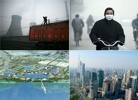A lengthy article in Popular Science Magazine looks at Dongtan and the other planned eco-cities in China, and argues that even without foreign architects’ help, China already has the ability to turn around its own environmental destruction:
The plans for Huangbaiyu”one of the half-dozen eco-cities, megalopolises and capitals of pollution I visited this spring to gauge whether China can engineer itself out of environmental catastrophe”were drawn by none other than William McDonough, the celebrated former “Green Dean” of the University of Virginia’s architecture school and godfather of America’s sustainable-design movement. In 1996 McDonough was the first, and so far only, individual to win the White House award for green design…
Huangbaiyu, in far northeastern China, was the first development project by the China-U.S. Center for Sustainable Development, a nonprofit McDonough started with Deng Nan, the daughter of former Chinese leader Deng Xiaoping. McDonough’s drawings depicted a beautiful teardrop of a village filling a forested valley. Its homes were to feature solar panels, eco-bricks made of hay and clay, and southern exposure to maximize sunlight…The local entrepreneur selected to build the new homes, Dai Xiaolong, who is also the village chief, took out nearly $1 million in loans to pay for construction. Convinced that Huangbaiyu would be famous around the world, the first of a wave of green cities across China, he also took out thousands of trademarks”Huangbaiyu Windows, Huangbaiyu Motors, Huangbaiyu Refrigerators”and waited to cash in.
The article goes on to explain the bigger picture of China’s environmental crisis and how it can get itself out:
…The first thing to understand is that China’s problem is our own. For every Chinese peasant who moves to the city”400 million are expected to do so in the next two decades, the greatest urban migration in history”the world loses someone who lives off the land and gains someone who lives on the grid. This year, for the first time ever, the planet has more urbanites than rural residents, a shift attributable in large part to China and its dozens of million-person cities you’ve never heard of. City dwellers in the developing world use at least three times as much energy as those in the country. The richer they get”the richer China gets”the more they use. China’s economic boom, a 10 percent increase in GDP every year, is twice that of America’s at the height of the dot-com era and shows no signs of relenting. Half of the world’s new buildings go up in China. The country has constructed the equivalent of the U.S. highway system in a decade. It adds the electricity use of Norway, 102 gigawatts, to its power grid every year and builds the equivalent of three coal-fired electricity plants every week (not one, as is usually reported). Last year, it produced 2.3 billion metric tons of coal, 40 percent of the world’s total and more than the U.S., Russia and India combined. [Full text]








